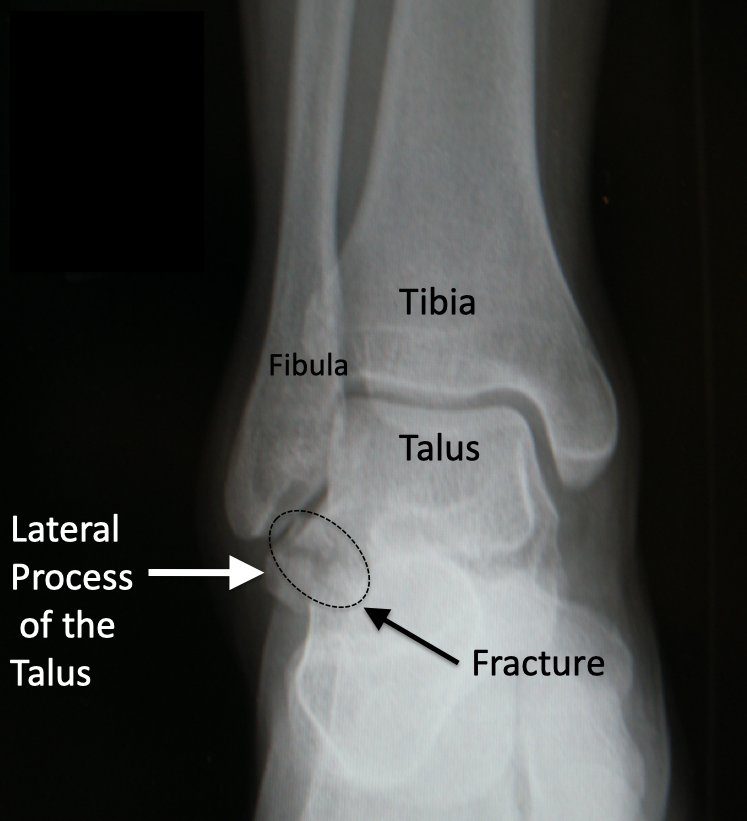With lots of snow during the winter months, many people are flocking to the mountains to snowboard. While carving turns and fresh powder brings joy to snowboarders the sport is not without its risks. A lateral talar process fracture is an unusual fracture affecting the ankle area that is surprisingly common in snowboarders. This “snowboarder’s fracture” results from a sudden jarring stop combined with a rotation of the foot on the lower leg. The sudden jamming creates a fracture affecting the lower bone of the ankle (the talus). Pain and swelling is experienced on the lateral, or outside, of the ankle. Sometimes the fracture is relatively undisplaced, like the way a hard-boiled egg cracks. However, displacement of the fracture and involvement of the joint below the ankle, the subtalar joint, will often necessitate surgery.

Signs and Symptoms
This injury usually occurs after a fall or sudden jamming stop while snowboarding. Symptoms of a talar lateral process fracture include immediate pain in the outside of the ankle. Local ankle swelling on the outside of the ankle is also common. Weight-bearing may be difficult and cause considerable pain. Symptoms are often quite similar to a bad ankle sprain, and for many patients this is the initial diagnosis.
Imaging Studies of Lateral Talar Process Fractures
Standard complete x-ray series of the ankle includes three views. It is often only on one of these x-ray views that the talar lateral process fracture can be seen (Figure 1). As a result, the fracture is often missed or not seen on plain x-rays. The fracture pattern can vary from an undisplaced crack in the bone, to a series of small fragments of bone, to a relatively large fracture fragment, that is displaced.
More advanced imaging studies such as a CT scan or MRI are sometimes. This is the case if the diagnosis of a lateral talar process fracture or the size and displacement of the fracture is in question.

Treatment
One key to effectively treating a snowboarder’s fracture of the ankle is to make the actual diagnosis as this injury is often initially thought to be “just an ankle sprain”. Once a snowboarder’s fracture has been identified the amount of displacement will often dictate the treatment. If the lateral talar process fracture is essentially undisplaced it can be treated conservatively. Conservative treatment requires relative immobilization in a CAM boot, or cast, with limited or no weight-bearing while the fracture heals. It often takes 6–8 weeks before the fracture is adequately healed. At that time patients can more aggressively increase their weight-bearing activities and mobilization. After the fracture is adequately, healed therapy to regain motion and strength can be beneficial. Needless to say, this fracture often causes the snowboarder to miss a large chunk, or all, of the snowboarding season. 🙁 In addition, if the fracture involves a large part of the subtalar joint it may lead to chronic painful subtalar arthritis.
Surgical Treatment of Lateral Talar Process Fracture
If the snowboarder’s fracture is displaced or interferes with the function of the joint below the ankle (the subtalar joint) surgery is often required. If the fracture fragment is small or in multiple small pieces, surgically removing the fracture fragments is often all that is required. However, if the fracture fragment is relatively large, repositioning it back where it belongs and stabilizing it with a screw is usually the surgical procedure of choice.
Following surgery to address a lateral talar process fracture healing is required. This is longer if the fracture fragment has been retained and fixed with a screw. Usually it is six weeks before patients can be aggressively mobilized. Similar to patients who are treated nonsurgically physical therapy is often beneficial to improve motion and strength that has been lost as a result of the injury. Overall, it can take a number of months or even up to a year before patients reach their point of maximum improvement.
Edited January 29th, 2024